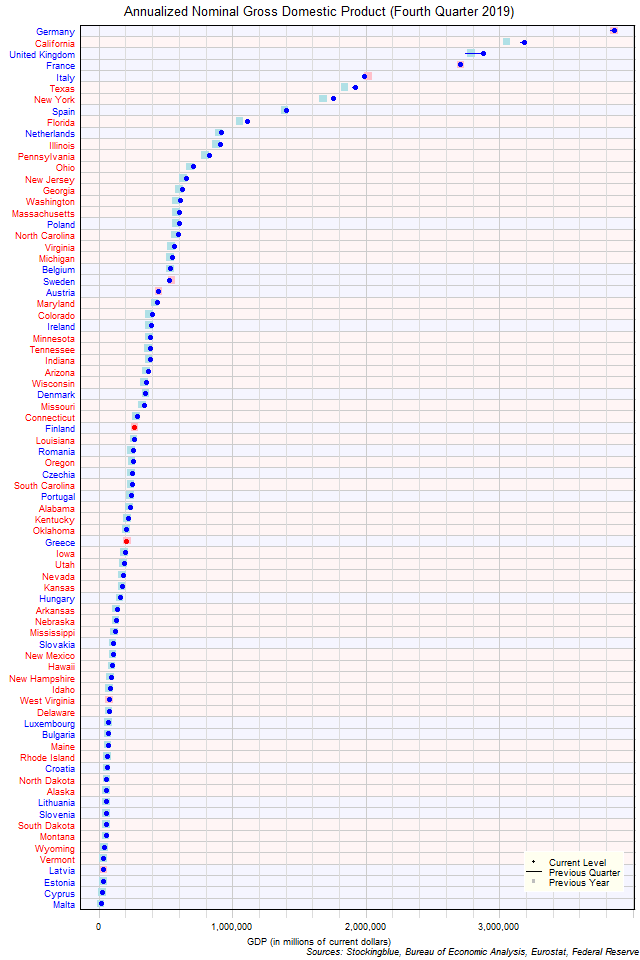
The chart above shows the annualized nominal gross domestic product (GDP) in each EU and US state as of the fourth quarter of 2019 in millions of US dollars, the change from the previous quarter, and the GDP one year prior. Only four states in both the EU and the US (three of which are from the EU) have an annualized GDP of over $2 trillion.
Findings
- The difference between the state with the largest GDP, Germany, and the state with the smallest, Malta, is $3,843,862.51 million (up from $3,812,602.69 million last quarter and down from $3,844,534.18 million last year). Germany and Malta had the largest and smallest GDP respectively both last quarter and last year.
- Germany has 255.99 times the GDP that Malta does. The ratio of largest GDP to smallest GDP was down from 258.73 last quarter and down from 266.26 last year.
- The median GDP in the 28 EU states is $253,435.20 million (up from $247,322.21 million last quarter and up from $240,685.69 last year) and the mean $660,692.57 million (up from $651,656.01 the previous quarter and up from $655,300.17 last year).
- The median GDP in the 50 US states is $252,688.10 million (up from $250,373.50 million last quarter and up from $241,859.95 last year) and the mean $429,171.76 million (up from $425,484.79 the previous quarter and up from $412,739.32 last year).
- The median GDP in the 78 EU and US states is $252,903.58 million (up from $248,496.76 million last quarter and up from $240,685.69 last year) and the mean $512,281.79 million (up from $506,674.46 the previous quarter and up from $499,812.45 last year).
- Seventy-six states saw their GDP rise in current dollars from the previous quarter (50 from the US and 26 from the EU) while two states saw their GDP drop in current dollars (0 from the US and 2 from the EU).
- Sixty-nine states saw their GDP rise in current dollars from last year (49 from the US and 20 from the EU) while nine states saw their GDP drop in current dollars (1 from the US and 8 from the EU).
- All EU drops in GDP, except for Finland's and Greece's quarterly drop and Sweden's annual drop, are attributed to currency rate fluctuations.
Caveats
- Data is from the fourth quarter of 2019, the third quarter of 2019, and the fourth quarter of 2018.
- The data is seasonally and calendar adjusted in current dollars except for Slovakia which is only seasonally adjusted in current dollars.
- Euros are converted to dollars at an average exchange rate of 1.11 for the fourth quarter of 2019, 1.11 for the third quarter of 2019, and 1.14 for the fourth quarter of 2018 according to historic rates listed at the Federal Reserve (see source link below).
- US data comes in an annualized format which the EU does not, thus EU data is annualized by multiplying the quarterly figure by four.
- US growth rates may differ from those provided by the Bureau of Economic Analysis as the BEA's growth rates are based on chained dollars in conjunction with the chain index or the quality index for real GDP. The growth rates listed here are based on nominal GDP.
- All figures are rounded to the nearest hundredth.
Details
In absolute terms, Greece saw the largest decrease over the previous quarter with a drop of $1,763.57 million. The United Kingdom had the largest growth with a gain of $134,901.41 million. Year over year, Italy had the largest decrease with a drop of $27,100.43 million while California had the greatest increase with a gain of $130,380.00 million.
In relative terms, Greece had the largest decrease over the previous quarter with a 0.85% drop in GDP while the United Kingdom had the greatest increase with a 4.92% rise in GDP. Year over year, Sweden had the largest decrease with a 2.75% drop in GDP while Romania had the largest growth with a 6.40% rise in GDP.
Germany accounted for just under one-tenth of the economic output of the 78 EU and US states at 9.66%. It, with California and the United Kingdom accounted for just under one-fourth of the economic output of the 78 states at 24.82%. Adding in France and Italy amounts to just over one-third the economic output of the 78 states at 36.57%.
Poland (from 19th to 18th largest economy in the EU and US out of 78), Romania (from 39th to 38th), Czechia (from 41rd to 40th), Oklahoma (from 46th to 45th), and Bulgaria (from 64th to 63rd) overcame one state each over the previous quarter. North Carolina (from 18th to 19th), Oregon (from 38th to 39th), South Carolina (from 40th to 41rd), Greece (from 45th to 46th), and Maine (from 63rd to 64th) were each bested by one state. Year over year, Michigan (23rd to 21st largest GDP) bested two states. On the flip side, Sweden (20th to 23rd) fell three spots.
Four EU states bested four US states over the quarter and three EU states bested three US states over the year. One US state bested one EU state over the quarter and six US states bested five EU states over the year.
Sources
Eurostat. 2020. "GDP and Main Components." Accessed April 22, 2020. https://appsso.eurostat.ec.europa.eu/nui/show.do?query=BOOKMARK_DS-406779_QID_265259FB_UID_-3F171EB0&layout=TIME,C,X,0;GEO,L,Y,0;UNIT,L,Z,0;S_ADJ,L,Z,1;NA_ITEM,L,Z,2;INDICATORS,C,Z,3;&zSelection=DS-406779UNIT,CP_MEUR;DS-406779INDICATORS,OBS_FLAG;DS-406779S_ADJ,SCA;DS-406779NA_ITEM,B1GQ;&rankName1=UNIT_1_2_-1_2&rankName2=INDICATORS_1_2_-1_2&rankName3=NA-ITEM_1_2_-1_2&rankName4=S-ADJ_1_2_-1_2&rankName5=TIME_1_0_0_0&rankName6=GEO_1_2_0_1&sortC=ASC_-1_FIRST&rStp=&cStp=&rDCh=&cDCh=&rDM=true&cDM=true&footnes=false&empty=false&wai=false&time_mode=NONE&time_most_recent=false&lang=EN&cfo=%23%23%23%2C%23%23%23.%23%23%23.
Federal Reserve. 2020. "Foreign Exchange Rates." Accessed April 23, 2020. https://www.federalreserve.gov/releases/g5/.
US Bureau of Economic Analysis. 2020. "GDP by State." Accessed April 21, 2020. https://www.bea.gov/data/gdp/gdp-state.